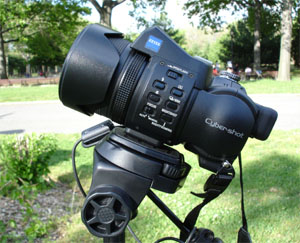Dec 22, 2025
Dec 22, 2025
 Digital cameras make picture-taking fun, but they don't necessarily make it easy. When you get home from a long day of picture snapping only to find that your digital images do not convey the impact you wanted, disappointment is an understandable reaction.
Digital cameras make picture-taking fun, but they don't necessarily make it easy. When you get home from a long day of picture snapping only to find that your digital images do not convey the impact you wanted, disappointment is an understandable reaction.
But the road to better digital photography does not have to be long and arduous. Learning a few simple precepts about how to make your images more interesting can go a long way toward giving you the satisfaction you deserve from your investment in a digital camera.
Watch the Light
Good photographs are all about light. The word "photography," in fact, has its roots in the Greek and means, roughly, "drawing with light."
Often what separates a good photograph from a mediocre one is how the photographer has used light to advantage. Light serves to draw out your subject from the elements around it. So when taking a digital image, be aware of how the light is accenting your subject.
Specifically, it's generally a good idea to have the sun behind you or slightly to the side when you take a picture - rather than in front of you. Think of the sun as a giant lamp, and use it, when possible, to make your subjects stand out.
Don't let the sun work against you. If you shoot into the sun - with the sun behind your subject, for example - your digital camera will expose for the sun, and your subject will end up too dark.
You can also use props to control the light, when possible. Simple reflective surfaces can be used to bounce light toward your subject. Doing so can dramatically enhance the quality of your photography. Any reflective surface will do, or you can buy inexpensive, portable "reflectors" from your local photography store.
Watch the Background
If your subject is the most important element of your photographs, the background - what's behind and around your subject - is the second most important element. That's because a busy or distracting background can draw attention away from your subject and lessen the impact of the idea you wanted to represent in the photograph.
Strive for simplicity in the background. When possible, move your subject away from distracting backgrounds and consider blurring the background out by setting your camera to portrait mode or using the camera in aperture priority mode with an f-stop such as 2.8 or 4.0.
When taking pictures of people, be aware of how any background elements can alter a viewer's perception of the subject. Posing people directly in front of skinny trees or poles, for instance, can result in the dreaded "tree growing out of the person's head" effect when your photo is viewed.
Go off Centre
The instinct of many beginning digital photographers is always to put the subject in the very centre of the frame. Don't do it. Look at the photographs of professionals, and you'll see that they often place their subject to the side of a frame, or slightly off centre, to create a composition that's more dynamic and interesting.
There's something called the "rule of thirds" that photographers have used for a long time to describe how to compose a photograph. Essentially, the rule of thirds places an imaginary tic-tac-toe board on your viewfinder, with the centre square right in the middle of the frame. If you avoid putting the central subject of your image in that centre square, you're following the rule of thirds.
Get Closer
Try to take in too much with your photography, and you'll end up with pictures that do not draw the viewer's attention to any one specific element. So one trick that seasoned photographers use is to represent the whole with a part - a branch and colorful autumn leaf, for instance, rather than a wide shot with a couple of colorful trees among the other elements.
Most digital cameras today come with a "macro" mode - a special setting that allows the camera's lens to focus closer than it normally does. Put your digital camera in macro mode, and then see how close to a subject you can get while retaining the ability to focus the lens. Combine getting close with other lessons of good composition, and your photographs will almost instantly be more interesting to look at.
Get the Color Right
Digital cameras don't see colors the way we do. In the sun, blue will look different to your digital camera than blue in the shade or indoors under artificial light. That's why most digital cameras have what are called "white balance" settings that are pre-tuned to typical lighting situations. By default, digital cameras are set to "auto" white balance, but you can change the setting easily. Doing so will give you better color out of the camera and allow you to spend less time trying to get your images to look right into the computer.
01-Apr-2007
More by : Jay Dougherty